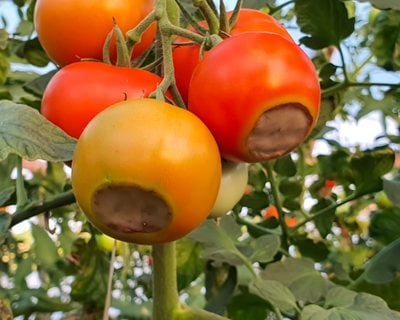Blossom End Rot on Tomatoes: Causes, Treatment & Prevention
What causes blossom end rot and how to prevent it.
Photo by Dan Gabriel Atanasie / Shutterstock.com
Blossom end rot is a common problem for tomato growers, causing dark, sunken spots on the bottom of developing fruit. It can appear when the fruit is still green or just starting to ripen and often surprises gardeners who think their plants are otherwise healthy. Learn more about how to water tomatoes properly to avoid this common problem.
Although you can’t save fruit that already has blossom end rot, you can correct the conditions causing it and protect the rest of your crop.
WHAT IS BLOSSOM END ROT?
Blossom end rot is a physiological disorder, not a disease. It happens when developing fruit doesn’t get enough calcium, usually because of uneven watering or other growing conditions. Because it isn’t caused by insects or fungi, fungicides and insecticides won’t help (Missouri Botanical Garden).
It appears as water-soaked spots that turn dark brown or black on the blossom end of the fruit and often affects the first fruits of the season. While tomatoes are most commonly affected, peppers and eggplant can also develop the disorder. Each fruit develops symptoms individually; blossom end rot doesn’t spread from one fruit to another.
WHAT CAUSES BLOSSOM END ROT?
Blossom end rot happens when developing fruit doesn’t get enough calcium during cell formation. The soil may contain calcium, but the plant can’t always move it into the fruit. Common causes include:
- Inconsistent soil moisture: Dry soil followed by heavy watering or rain disrupts calcium uptake.
- Low soil pH: Acidic soil (pH below 6.2) makes calcium less available.
- Excess nitrogen: Promotes rapid foliage growth, diverting calcium away from fruit.
- Root damage: Cultivating too deeply around plants can damage roots and limit calcium uptake.
Tip: A simple soil test can tell you your pH and calcium levels.

Photo by: Photo by: Mila Makhova
Quick Tips- Check soil moisture daily during hot weather
- Mulch early in the season to regulate soil moisture
- Use balanced fertilizer; avoid sudden nutrient spikes
- Test soil pH yearly and amend if needed
- Choose tomato varieties less prone to blossom end rot (smaller-fruited types are often less affected)
HOW TO PREVENT BLOSSOM END ROT
You can’t fix fruit that already has blossom end rot, but these steps will help prevent it from appearing in future fruit.
1. Keep soil moisture even
- Water deeply and consistently, 1 to 2 inches per week is typical.
- Mulch with straw, leaves, or compost to help retain moisture.
- Avoid letting soil dry out completely between waterings.
- Learn more about how to properly water tomatoes.
2. Check soil pH and calcium
- Test soil pH (target range: 6.2 to 6.8) and calcium levels before planting.
- Apply lime or gypsum only if recommended by your soil test.
3. Fertilize carefully
- Avoid high-nitrogen fertilizers, especially early in the season.
- Choose a balanced fertilizer to encourage steady growth.
- Tip: When fertilizing, opt for nitrate-based nitrogen rather than ammonium forms, as ammonium can compete with calcium uptake and increase the chance of blossom end rot. (University of Wisconsin Plant Disease Diagnostics Clinic)
4. Use foliar calcium sprays (temporary help)
- Sprays with calcium chloride or calcium nitrate can help new fruit but won’t fix existing damage.
- Apply according to label directions and combine with proper watering practices.
5. Remove affected fruit
- Damaged fruit will not recover; remove it to redirect energy into healthy growth.
Tomato Myth: Eggshells Fix Blossom End Rot
While it’s a common tip to add eggshells to your soil, eggshells take months, or even longer, to break down. For calcium to reach your plants in time, it needs to be water-soluble. Stick to calcium sprays (like calcium nitrate) for immediate help, and correct soil pH for long-term balance.
Gary Pilarchik of The Rusted Garden, offers an emergency treatment and prevention solution for blossom end rot with a limestone slurry. Check out the full video.
FREQUENTLY ASKED QUESTIONS
Does blossom end rot affect peppers and eggplant?
Yes. Both peppers and eggplant are in the same plant family as tomatoes (Solanaceae) and can develop the same dark, sunken spots when calcium uptake is disrupted. Prevention and treatment methods are identical: consistent watering, balanced soil fertility, and proper pH.
Can you eat tomatoes with blossom end rot?
Yes, simply cut away the damaged portion. The rest of the fruit is safe to eat, though the texture and flavor may be affected near the damaged area.
Will Epsom salt fix blossom end rot?
No. Epsom salt adds magnesium, not calcium, and can actually make blossom end rot worse by interfering with calcium uptake. Use lime, gypsum, or calcium sprays instead, but only if a soil test shows calcium is low.
Will the problem spread to healthy fruit?
No. Blossom end rot is not contagious; each fruit develops symptoms on its own. Once conditions are corrected, future fruit will form normally.
How fast can blossom end rot be fixed?
Existing spots won’t heal, but new fruit can be symptom-free within two to three weeks if soil moisture and calcium levels are corrected.
ABOUT THE AUTHOR
Linda Hagen is a writer and content coordinator at GardenDesign.com, where she combines firsthand gardening experience with expert insights. Based in Southern California (Zone 9B), she’s passionate about vibrant, pollinator-friendly gardens and believes the best lessons come from a trial-and-error approach to growing .
RELATED:
Tomato Plant Diseases, Pests, and Problems
Eco-Friendly Pest & Disease Control
Black Spot on Roses

